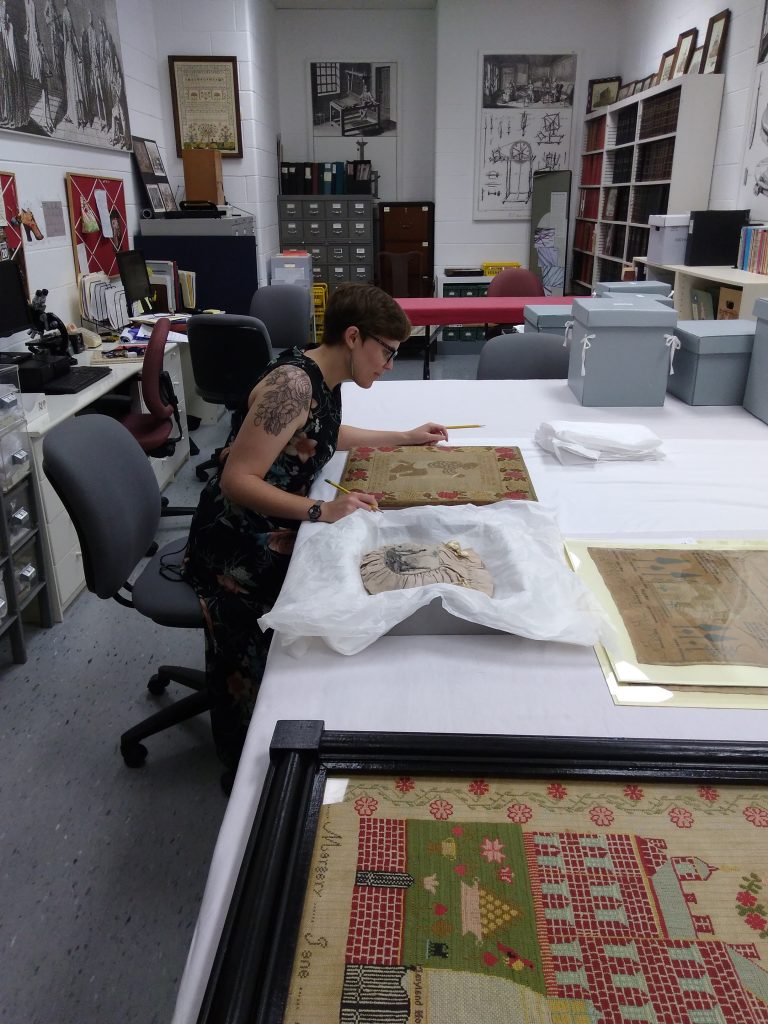Women’s Textile Crafts and their Construction of Political Identities
by Mariah Gruner
Sitting in the Dewitt Wallace Collection and Conservation Building at the Colonial Williamsburg Foundation, I confronted the stitched, mostly woolen image of a kneeling, enslaved man, his wrists and ankles bound in chains. Here was a historically feminine, domestic craft being used to depict an iteration of the Josiah Wedgwood antislavery seal, asserting a clearly political message.
While records of textiles produced for sale at antislavery fairs in the 1820s-50s are relatively abundant, samplers that overtly participate in the antislavery movement rarely emerge in the archive. With the generous support of the Decorative Arts Trust, I was able to use a Summer Research Grant to engage in close study of a few extant pieces and to mine the associated museum files. Close examination of these objects is key to gaining insights into their significance and relationships to other textile crafts made by women in the first half of the nineteenth century.
For example, the wool piece described above was discovered in Pennsylvania and materially and stylistically resonates with Berlin woolwork, but the verses are from an 1804 British ballad and the needlework features surprising silk highlights in the figure’s chains. Pairing fashion with politics, it reminds us of the transatlantic nature of the antislavery movement and its relationship to popular culture, the force of combining historically feminized crafts with political messages, and the complex meanings behind (almost exclusively white) women’s repetition of images of enslaved suffering and dehumanization.
I researched the complex relationship between women’s textile crafts and their construction of political identities, analyzing the ways in which women used textile crafts (associated with normative femininity) to construct increasingly public and political identities. Abolitionist textiles provide a particularly salient example of women using their alignment with morality and sentiment to create political platforms, revealing the long history of strategic essentialism.
A cradle quilt in Historic New England’s archives practically crackles with the charge of bringing together maternal identity with fiercely antislavery sentiments. I traveled to Historic New England’s collections in Haverhill, MA, to examine this piece, sold at the Boston Female Anti-Slavery Society’s 1836 Anti-Slavery Fair and likely stitched by Lydia Maria Child (figure 1). The central panel is inked with a poem that asks women, as they wrap their own children in the quilt before bed, to “Think of the negro mother, when/Her child is torn away,/Sold for a little slave-oh then/For that poor mother pray!” These verses reveal the political nature of the domestic, familial scene, bringing maternal relationships into public debate.
These are just two examples of the antislavery textiles I studied, thanks to this summer research grant. In my travels to Colonial Williamsburg, the Massachusetts Historical Society, and Historic New England, I also examined workbags produced by women’s antislavery societies (figure 2), similar iconography on sugar bowls and tobacco boxes, and written records from The Boston Female Anti-Slavery Society. Actual encounter with these objects was key to my methodology. While records are illuminating, they cannot capture the textures, details, and ineffable charges that made and still make these textiles politically and emotionally resonant.
Watch a recording of Gruner’s The Tethering Stitch, The Liberating Stitch: The Frictions of Abolitionist Women’s Needlework lecture from the 2019 Emerging Scholars Colloquium on our YouTube channel.
Mariah Gruner is a PhD Candidate at Boston University. She was a recipient of a 2018 Summer Research Grant and presented at several Emerging Scholars Colloquia.
About The Decorative Arts Trust Bulletin
Formerly known as the "blog,” the Bulletin features new research and scholarship, travelogues, book reviews, and museum and gallery exhibitions. The Bulletin complements The Magazine of the Decorative Arts Trust, our biannual members publication.









